15 Types Of LARGE BLACK And WHITE BIRDS (Guide With Photos)
Did you recently come across a large bird with black and white feathers, and want to know what species it was?
Identifying large birds that have both white and black plumage is not as easy as it might seem, since there are surprisingly many birds in North America that fit this description.
To help you identify the bird you saw, we’ll cover all the large black-and-white birds of North America in this guide.

What are the types of large black and white birds?
There are 15 types of large birds in North America that are black and white, which are covered in full detail below.
Black-billed Magpie
Scientific name: Pica hudsonia
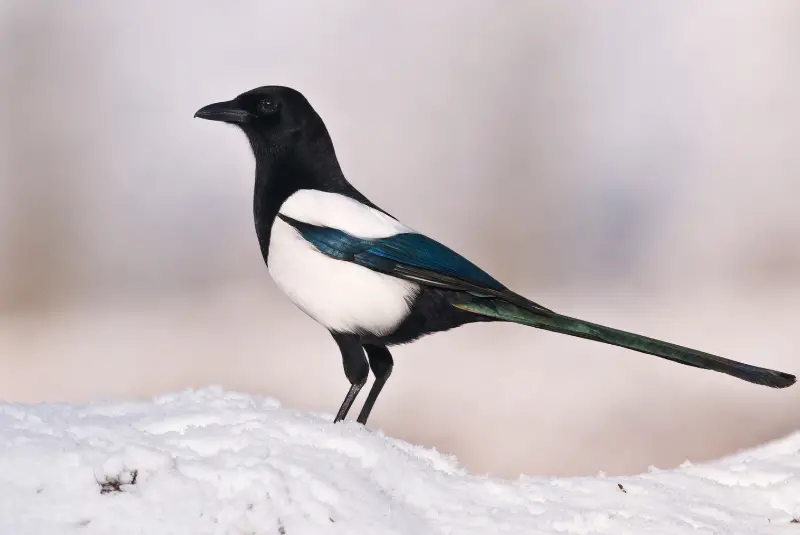
The Black-billed Magpie is a large black and white songbird. The sexes are alike, and have a black body and head, contrasting with a white shoulder patch on their dark blue wings.
These magpies also have white underparts, and a long bluish-green tail.
They are birds of western North America, where they are found year-round in open areas and lightly wooded habitats.
Osprey
Scientific name: Pandion haliaetus

The Osprey has a wingspan of up to 69 in (5.5 ft), and resembles an eagle in size.
It is usually easy to identify an Osprey due its black and white coloration. It has a white belly and chest, which contrast with its grayish black upperparts and wrist patches on its lower wings.
This large raptor is the only bird of prey species that plunges into water in order to catch fish, often becoming entirely submerged as it attempts to grab a fish with its feet.
Due to their style of hunting, Ospreys are almost always found close to a body of water, except during migration, when they will cross areas without water.
Swallow-tailed Kite
Scientific name: Elanoides forficatus
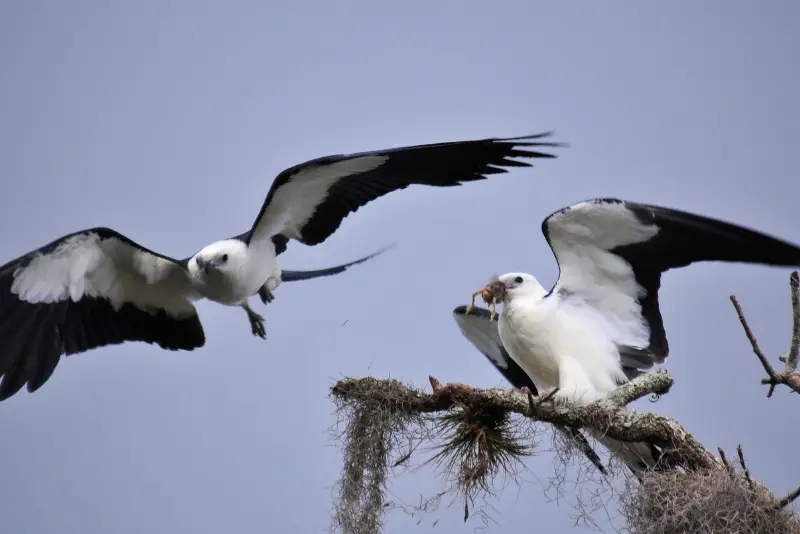
With a wingspan of up to 5 feet, this elegant raptor is the largest kite species in North America.
It is easy to identify a Swallow-tailed Kite due to its combination of its bright white underparts with black tipped wings and tail, as well as a deeply forked tail.
This raptor is a skilled hunter and capable of catching insects in flight, as well as snatching lizards from branches.
California Condor
Scientific name: Gymnogyps californianus

A huge bird with an enormous wingspan of up to 9 feet (2.7 meters), California Condors are large black birds with white under wings. This huge raptor can weigh as much as 20 pounds (9 kilograms).
When it takes to the air and you can view it from below, the California Condor looks like a large black bird with a white stripe on its wing.
California Condors were once found throughout most of North America but today they live only in small areas of the southwestern United States and Baja California in Mexico.
Black Vulture
Scientific name: Coragyps atratus
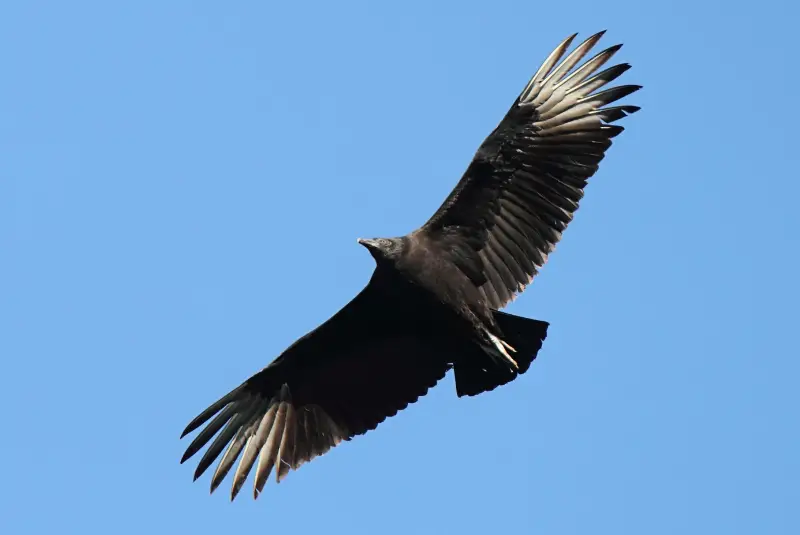
Black Vultures are widespread but uncommon breeding birds in the southeastern United States, where they can be seen all year round.
These vultures are large black birds with white wing tips. They have a naked head with wrinkled, dark skin. Adult pairs remain in their breeding territories year-round.
In contrast to Turkey Vultures, these vultures don’t have a keen sense of smell. Because of this, they often use Turkey Vultures as “scouts” to find roadkill.
Crested Caracara
Scientific name: Caracara plancus
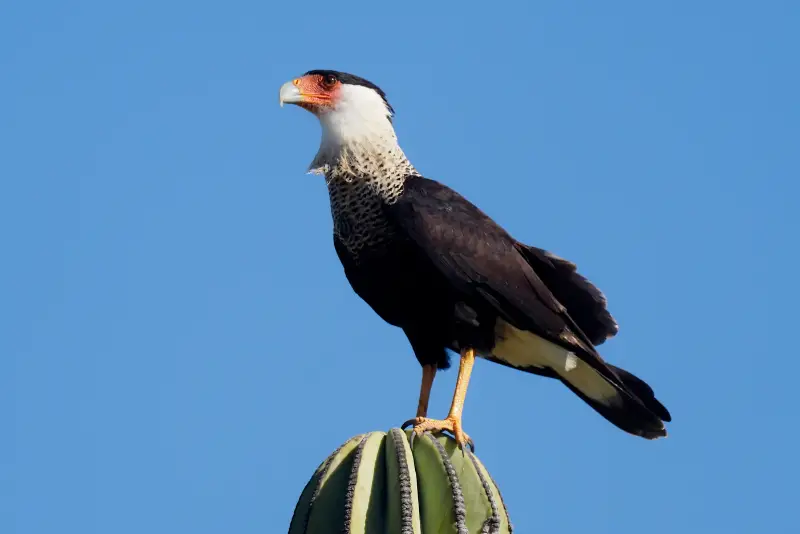
While caracaras belong in the falcon family, they have a very distinctive appearance, due to their large bill and long legs, and their unusual habit of regularly walking on the ground.
Crested Caracaras are rare breeding birds in southern Texas and parts of Florida, but their numbers have recently been increasing.
Similar to vultures, these black and white raptors often feed on carcasses. They are most often observed perched on a tall tree, or flying low over the ground.
White-headed Woodpecker
Scientific name: Dryobates albolarvatus
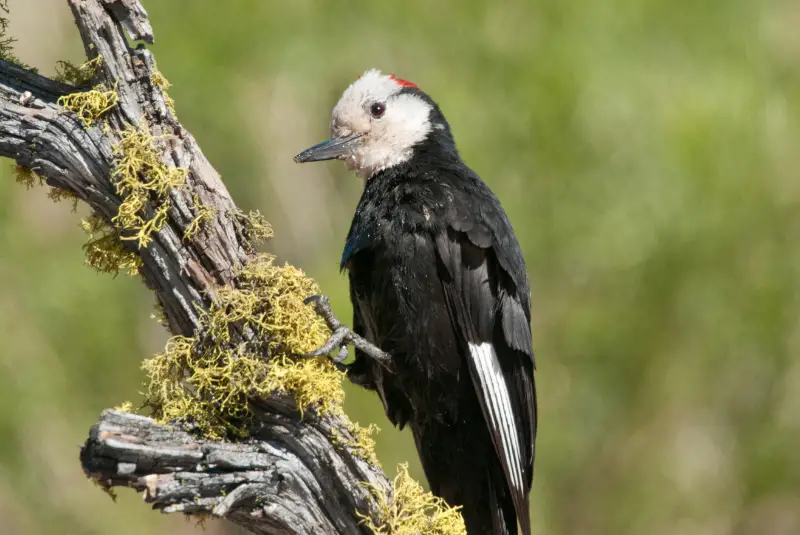
The White-headed Woodpecker is a bird of the western United States, where it is found in mountainous areas.
This large woodpecker is mostly black with small areas of white, including a white head and a white stripe on the wing. In addition to this, males also have a bright red patch on the rear part of their head.
These woodpeckers live in pine forests, where they forage for seeds by hammering seeds out of pine cones.
Common Loon
Scientific name: Gavia immer
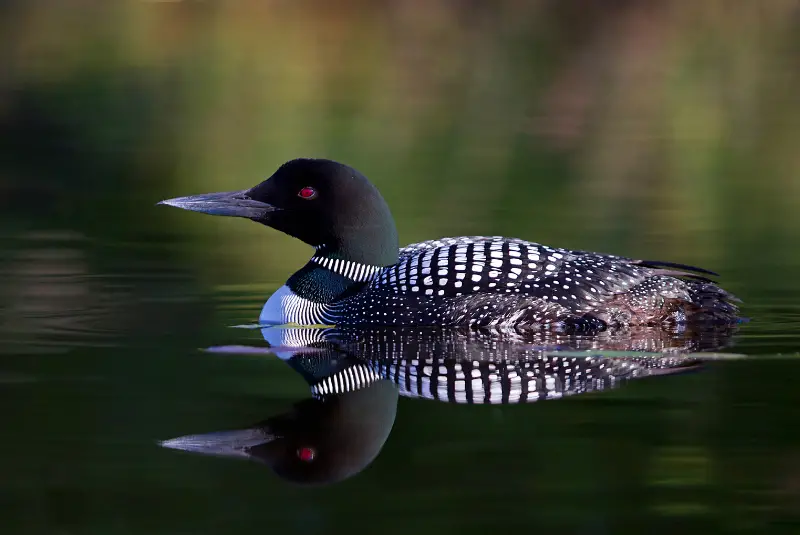
If you’ve spotted a black waterbird with white dots, this is most likely the Common Loon (also known as the Great Northern Diver).
These large water birds breed in northern areas of North America and can be seen along the coastline of Florida during the winter.
The common loon is a fantastic diver and is super stealthy when it hunts underwater, allowing it to sneak up on fish without even a splash. It can dive to depths of up to two-hundred fifty feet.
Anhinga
Scientific name: Anhinga anhinga
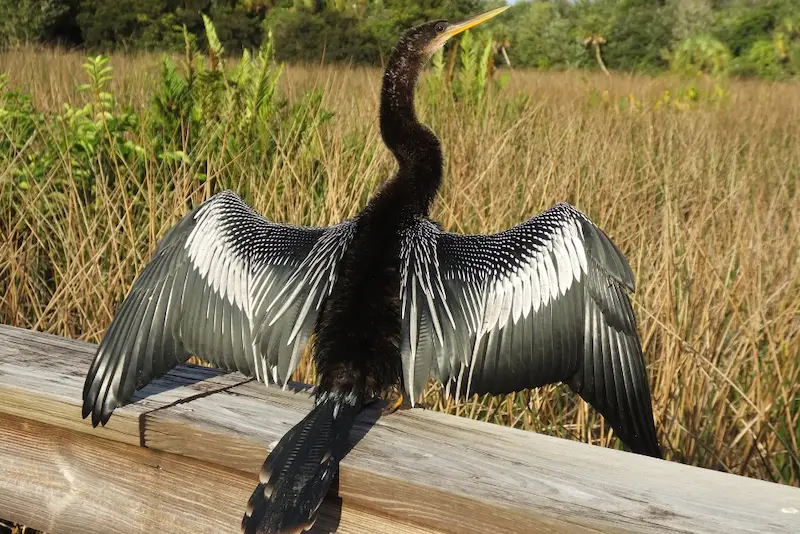
The Anhinga looks similar to a cormorant, but has a snake-like neck, which it uses to catch fish underwater.
When this diving bird is in the water, it’s common to see only the head and neck protruding above the water surface.
Adult male Anhingas are largely black with white areas on their wings, while females have a dark gray body with a brown head and neck.
Both sexes have white stripes on their wings that look like white speckles when the wings are folded.
Wood Stork
Scientific name: Mycteria americana
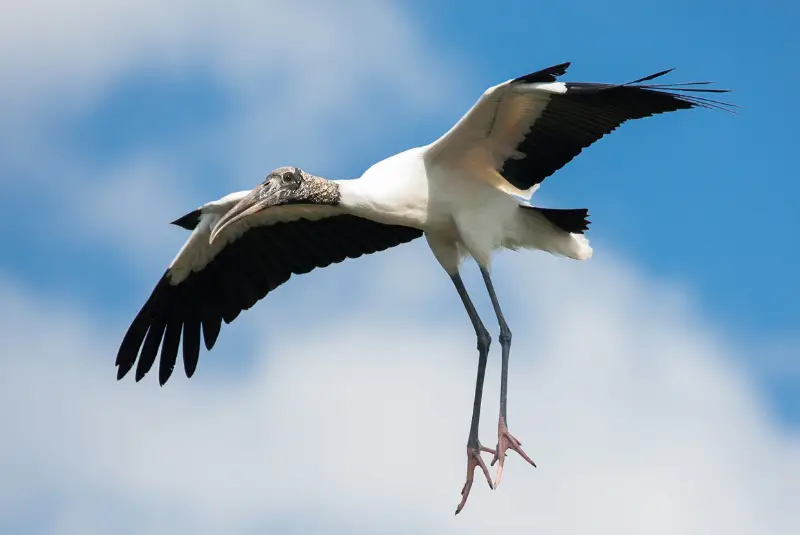
It’s easy to identify a Wood Stork if you can see it up close, due to its entirely white plumage combined with black wing feathers, as well as a bald dark head.
The Wood Stork has a long bill that curves slightly downwards. And while its tail and wing tips are black, this is usually only apparent when you see a Wood Stork in flight.
The Wood Stork is a large bird, similar in size to a Great Egret, but is easily distinguishable from that species by its curved beak.
Black Skimmer
Scientific name: Rynchops niger
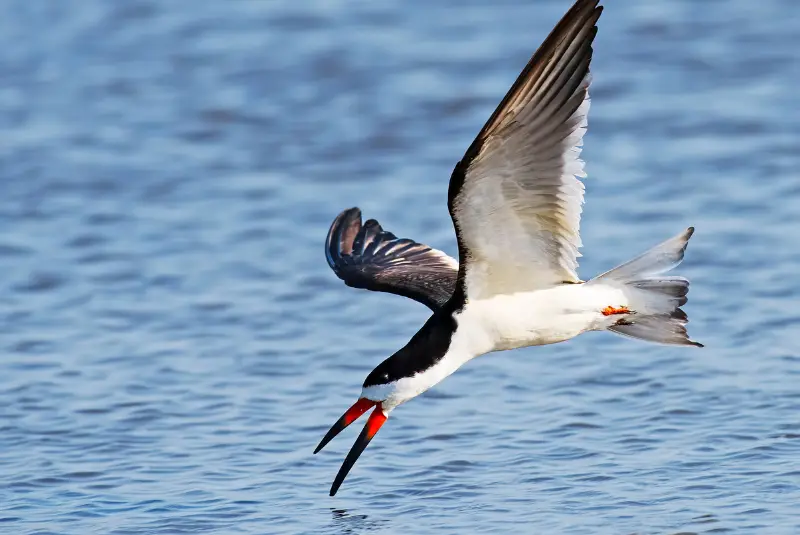
The Black Skimmer is a striking shore bird that is easy to identify both by its appearance and its behavior.
Its black upperside contrasts with a bright white underside, and with a long red bill. The lower part of its bill is significantly longer than the upper part.
It catches fish by flying along the water surface, while pulling its lower bill through the water. When the lower bill encounters a fish, the bill slams shut to catch its prey.
Black-necked Stilt
Scientific name: Himantopus mexicanus

This wading bird is easy to identify by its striking black-and-white plumage coupled with long reddish pink legs, and a long thin beak.
With long legs that are more than 9 inches long, this wading bird has the longest legs of any bird in proportion to its body size.
The preferred breeding habitats of these beach birds are shallow marshes, but during the winter they are also found along the coast.
American Avocet
Scientific name: Recurvirostra americana
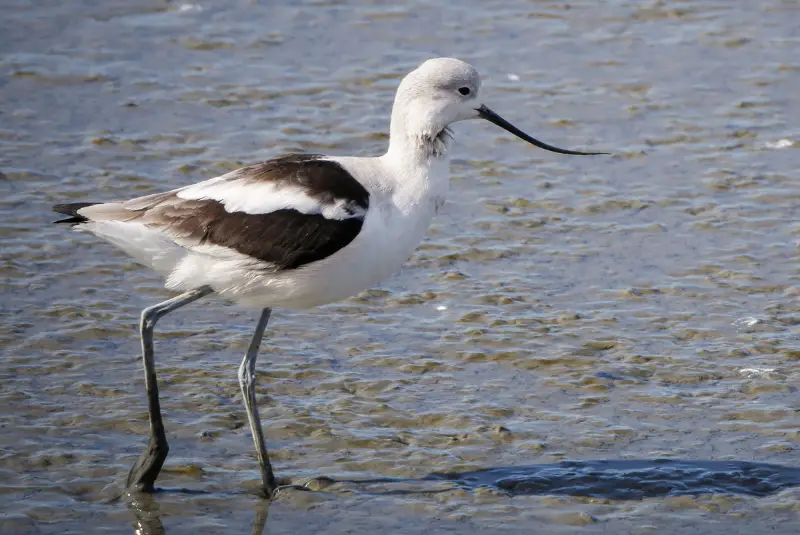
The American Avocet is a large wading bird that breeds in the plains of northern North America, and winters along the coastlines of the southern United States.
These black and white shorebirds have a long bill that is unusual in that it is curved upwards, which makes it unique among all the birds on this list.
American Avocets are often encountered together with Black-necked Stilts at coastal lagoons and mudflats.
American Oystercatcher
Scientific name: Haematopus palliatus
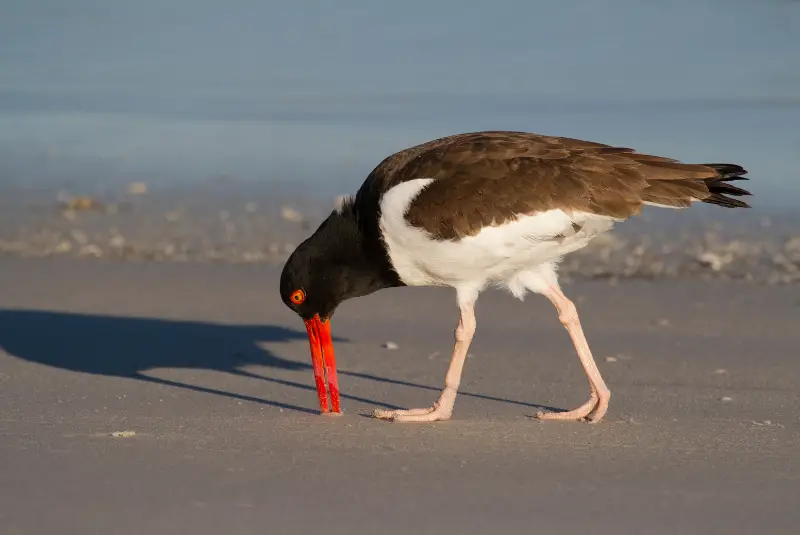
American Oystercatchers are beautiful beach birds with striking black-and-white coloration.
They have a jet black head and neck, which contrasts with a bright white belly and a long, heavy red bill.
The Oystercatcher is a bird of the tidal flats, where it follows the tidal patterns to feed on shellfish during low tide.
The heavy bill of the Oystercatcher helps it to pry open the shells of mollusks, and it also serves for hammering their shell until it shatters.
Northern Gannet
Scientific name: Morus bassanus
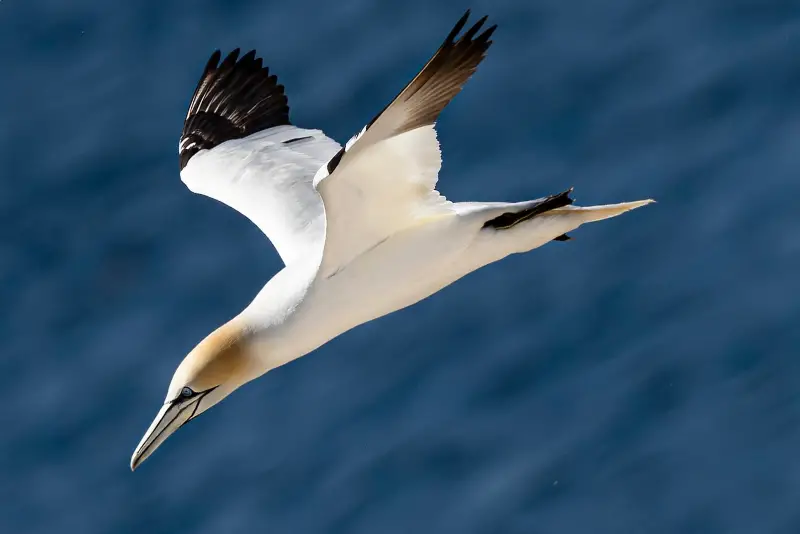
These birds are impressively large and are nearly as big as albatrosses. They have a largely white body with black wingtips, and a small dark mask.
If you see these big birds, notice how fast they dive in order to catch their food, and plunge into the water only to resurface with a mouth full of fish.
Northern Gannets nest on the cliffs of northern North America, but winter along the entire coastline of the eastern United States and the Gulf Coast.
Final remarks
In summary, here are the15 types of big black and white birds in North America:
- Black-billed magpie
- Osprey
- Swallow-tailed Kite
- California Condor
- Black Vulture
- Crested Caracara
- White-headed Woodpecker
- Common Loon
- Anhinga
- Wood Stork
- Black Skimmer
- Black-necked Stilt
- American Avocet
- American Oystercatcher
- Northern Gannet
If you’ve spotted one of these large birds while bird watching in your backyard, hopefully this ID guide will help you identify it quickly and easily.
And if you enjoyed this article, check out our guide to the small black and white birds of North America.
